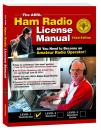 |
‘Wired telegraph is a kind of a very, very long cat. You pull his tail in New York and his head is meowing in Los Angeles. Radio operates exactly the same way, the only difference is that there is no cat.’ |
Fall, 2016
Our tweet using APRS packets through the international space station last semester got some attention.
This class aims to prepare students for the technician class amateur radio licensing exam, with emphasis on demonstrating what you could do once you get the license. This class welcomes ANYONE interested in studying for the test and taking it.
Prerequisites: None!
FAQ:
Q: I'm a ______ major. Is this class for me? A: Yes!
Q: How many units should I take? A: 1 unit for attending the 7 lectures, completing the assignments, and taking the test.
Q: I'm a graduate student, can I take the class? A: Absolutely! but please register to EE298
Q: Can I audit the class? A: Of Course!
Intructor of record
Instructor
Tom Zajdel
Email: zajdel@eecs.berkeley.edu
Assistant
Calvin Li
Email calvin.li.lt@berkeley.edu
Class Time and Location
Weekly lectures, from September 1 through November 3rd
Thursdays 6:30pm-8:30pm Cory 521
Licensing Exam
November 3rd starting 6:30pm, Wozniac Launge (NOTE SPECIAL LOCATION!)
 Technician Ham Radio License Manual 21$ Amazon
Technician Ham Radio License Manual 21$ Amazon
Ham Radio
From ARRL: Amateur Radio (Ham Radio) is a popular hobby and service in which licensed Amateur Radio operators (hams) operate communications equipment. Although Amateur Radio operators get involved for many reasons, they all have in common a basic knowledge of radio technology and operating principles, and pass an examination for the FCC license to operate on radio frequencies known as the “Amateur Bands.”. These bands are radio frequencies reserved by the Federal Communications Commission (FCC) for use by ham radio operators.
The role of amateur radio has obviously changed with the presence of the internet. Remarkably, amateur radio today offers unique opportunities and capabilities due to its independence on commercial infrastructure. For example, it is a legal ground for hands-on experimenting with wireless communication technology and it allows communication in emergencies and from remote areas.
What can you do as a ham?
Talk to people (near and far)
Build stuff (amps, sdr’s, antennas, receivers)
Emergency communications (emcom)
First person view (FPV) vehicles (drones) at much higher power
Hit satellites, moon, meteors, airplanes (with radio waves! … not something else)
Digital communication with Automatic Positioning and Reporting System, packet radio
Use Repeaters covering bay-area, California and the United States, mesh networks
Class Schedule
| Week | Date | Topics | Reading |
| 1 | Sep 1 | Radio and Signal Fundamentals Demo: SDR | Chapters 1 & 2 |
| 2 | Sep 8 | Electricity, Components and Circuits Demo: Digital Modes | Chapter 3 |
| 3 | Sep 15 | Propagation, Antennas, and Feed Lines Demo: Fun with Antennas | Chapter 4 |
| 4 | Sep 22 | Amateur Radio Equipment Demo: The Art of Morse Code | Chapter 5 |
| 5 | Sep 29 | Communication with Other Hams Demo: Communication Nets | Chapter 6 |
| 6 | Oct 6 | Licensing and Operating Regulations Demo: Field Day | Chapters 7 & 8 |
| 7 | Oct 13 | No class, office hours extended to 7:30pm | |
| 8 | Oct 20 | Safety Radio Log due | Chapter 9 |
| 9 | Oct 27 | No class, office hours extended to 7:30 pm Office Hour QSO due | |
| 10 | Nov 3 | Licensing Exam Session 6:30pm Wozniak Lounge (430-438 Soda Hall) | |
| 11 | Nov 10 | No class Reflection due |
Assignments
This course is a 1-credit class graded S/U. These assignments are designed to give you some experience on the air and are to be completed to earn a pass (S).
Radio Log, due October 20
Office Hour QSO, due October 27
Licensing Exam Session, November 3
Reflection, due November 10
Radio Log
You will keep a radio log throughout the semester, due on October 20. You will record 15 transmissions on each of the following bands or groups of bands: 70cm|2m, 20m, and 40m. Each log entry will consist of the following information (after this example):
| Date | Time | MHz | Callsign | Mode | RST | TX QTH | RX QTH | Comments |
| Jul 14 | 8:20pm | 7.235 | NU6XB | LSB | 59 | Berkeley, CA | San Mateo, CA | Go Bears! |
Office Hour QSO
In ham radio, two-way conversations are known as QSOs. As part of the course, you are asked to stop by office hours at the club station to carry out a QSO on the air (do so by October 27)! There will be two weeks without regular class sessions when office hours will be extended to accommodate those who cannot make regular office hour times.
Reflection
The final paper is a written reflection, 300-500 words, that describes your experience with amateur radio through the course, due on November 10. Feel free to write anything you like. Here are some questions to get you started:
What do you think of amateur radio having finished the course? What did you think of it before?
What do you think you will do with your license?
What was your favorite hands-on demo in the class?
Did you encounter anything interesting while working on your Radio Log?
Links
Earth-Moon-Earth communications: Moon Bouncing, Easy moonbouncing presentation
Aircraft Scattering Communications by bouncing off radio waves from airplanes